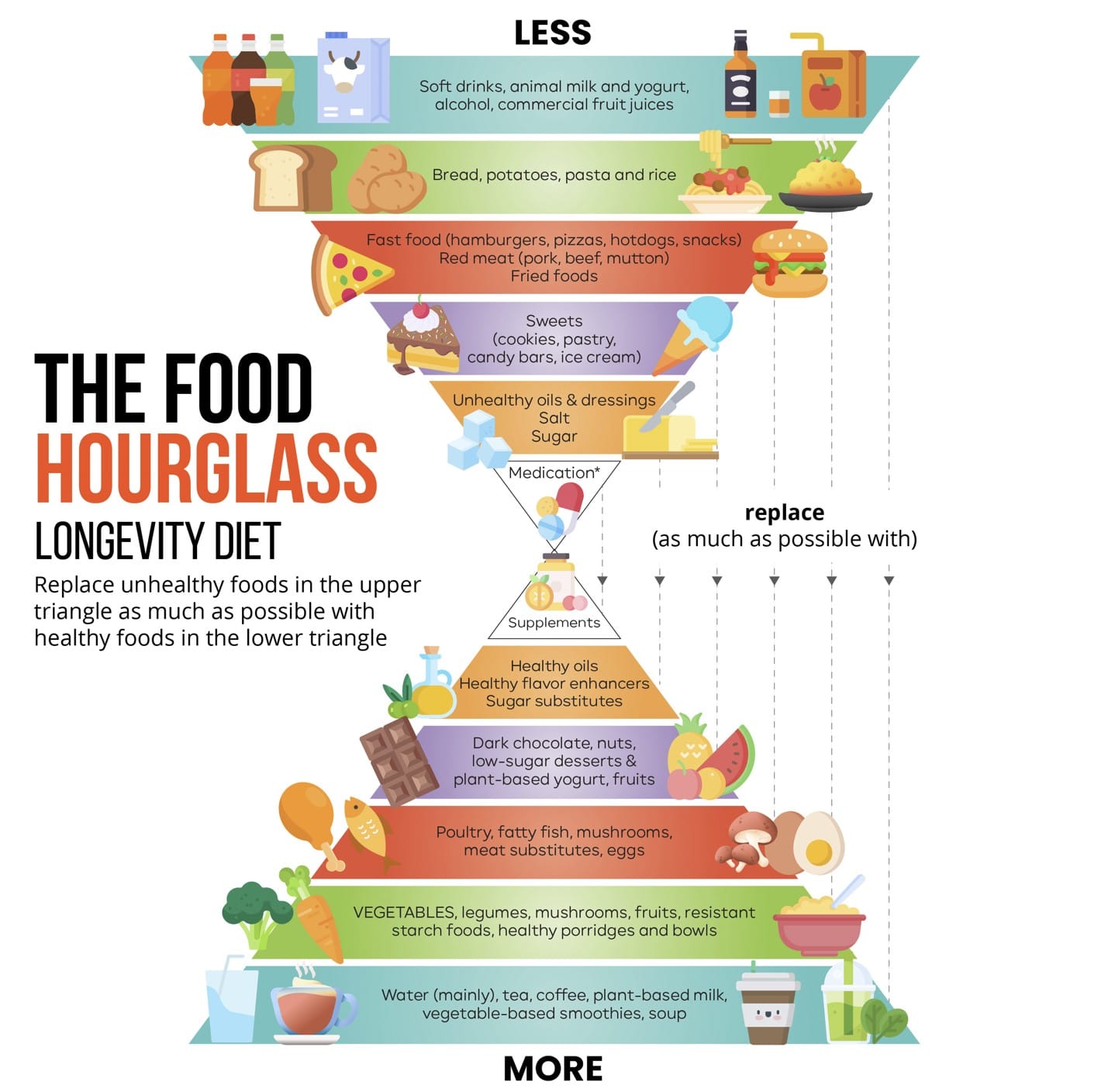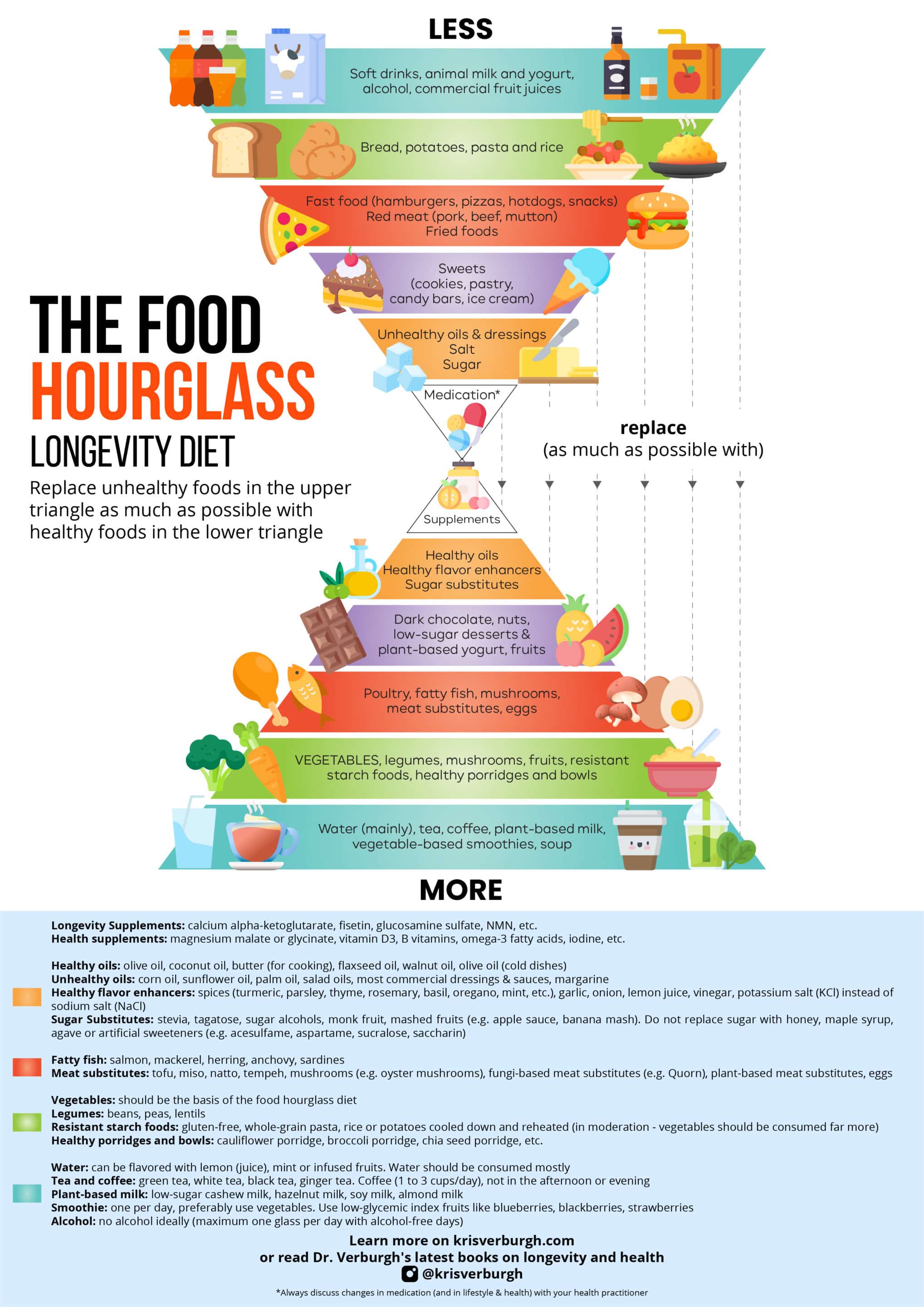
Why a longevity diet is the best diet
There are hundreds of different diets, thousands of diet books, and innumerable diet coaches and gurus all claiming they have the ultimate diet.
Especially the internet is a jungle of different diets and contrary nutrition advice. There are meat-based diets, fat-fueled keto diets, low carb and vegetarian diets. There are diets named after doctors who (re-)invented them, like the Atkins diet, Dukan diet, or Dean Ornish diet.
So how to see this wildly overgrown forest for the trees? How can we find out what the best diet is?
To find out what the best diet is we need to approach diets, and nutrition in general, in a new way: by basing ourselves on the science of aging. Knowing why we age helps us to provide far better diet and nutrition advice.
For example, knowing that proteins play an important role in the aging process, a high-protein diet might not be a good idea in the long-term, despite achieving lots of weight loss in the beginning.
So what is the best diet out there? The best diet is a diet that slows down aging. A longevity diet.
Given a longevity diet acts on fundamental processes of aging, such a diet reduces the risk of aging-related diseases such as heart disease, cancer and Alzheimer’s, given aging is the main driver of these diseases.
A nice bonus is that a longevity diet also leads to weight loss if one is overweight. Without having to count and restrict calories.
The Food Hourglass Longevity Diet
I developed the Food Hourglass Diet using the latest insights into aging. It focuses on slowing aging and increasing longevity.
The upper part of the Food Hourglass contains foods that are more unhealthy and one should eat less of, like red meat, starchy foods, and unhealthy fats.
The lower part contains healthy foods one should eat more of, like vegetables, legumes, white meat, fish, or mushrooms.
Thanks to the hourglass shape, one can easily see how to replace unhealthy foods with healthier alternatives.
For example, red meat (pork, beef, lamb) in the in the upper part of the Food Hourglass can be replaced with the healthier alternatives in the lower part, namely white meat (poultry), fatty fish, eggs, fungi-based meat alternatives (e.g. Quorn), tofu, or mushrooms.
Starchy, empty-calorie foods like bread, potatoes, pasta and rice in the top part of the Food Hourglass can be replaced with vegetables, legumes and mushrooms in the lower part.
Unhealthy oils (e.g. omega-6 rich like corn oil, sunflower oil, palm oil, sesame oil) in the upper part can be replaced by healthier alternatives, like olive oil or walnut oil.
You can download an image of the Food Hourglass at the bottom of this article.
The Food Hourglass Diet can be summarized in 9 simple rules.

The 9 rules of the Food Hourglass Diet
1. No or very little sugary foods
This means no or very little candy, snack bars, cookies, cake, pastry, soft drinks. Substitute these sugary foods with healthier alternatives, such as:
– Dark chocolate (70% cacao or more)
– Fruits: apples, pears, blueberries, strawberries, cherries, peaches, etc.
– Nuts: walnuts (rich in omega-3 fatty acids), hazelnuts, almonds (rich in vitamin E), cashews, etc.
– Low-sugar desserts: almond yogurt, soy yogurt, coconut yogurt.
2. Less starchy foods
Replace as much as possible bread, potatoes, pasta and rice with:
– Vegetables
– Legumes: beans, peas, lentils
– Mushrooms: shiitake, portabella, oyster mushrooms, etc.
– Quinoa.
So instead of potato mash, consume broccoli mash.
Instead of rice, consume Cannellini beans.
Instead of pasta, consume oyster mushrooms.
Bread in the morning can for example be replaced with:
– Healthy porridges: chia seed porridge, cauliflower-banana porridge, low-sugar oatmeal porridge, etc.
– Breakfast bowls: for example, a bowl containing blueberries, snippets of avocado, quinoa flakes mixed with vegetable milk or plant-based yogurt (low-sugar almond yogurt, coconut yogurt, soy yogurt, etc.)
– Other healthy breakfast alternatives: more coming soon. My new book on longevity will also contain healthy recipes for longevity).
3. Vegetables and legumes are the basis of a longevity diet, not starchy foods
Vegetables (especially) and legumes are the basis of a healthy longevity diet, not potatoes, pasta, rice or bread.
If you do want to eat now and then starchy foods, try to consume:
– Gluten-free products (even if you are not coeliac, gluten is a protein in grains that can damage the gut lining and be immunogenic): gluten-free pasta, gluten-free bread, or rice (which does not contain gluten anyhow).
– Whole-grain products: e.g. whole-grain pasta, and brown or black rice (not white rice).
– Resistant-starches: after cooking, let starchy foods (potatoes, pasta or rice) cool down in the refrigerator for a few hours or overnight, and then reheat them. The cooling-down process “crystallizes” the starches and turns them into healthy “resistant starch”, which causes considerably less high sugar peaks. Resistant starch is in fact a fiber which nourishes healthy bacteria in the gut, among other things.
4. Replace red meat with white meat, fish and meat alternatives
Replace red meat (pork, beef, lamb) with:
– White meat: poultry like chicken or turkey
– Fatty fish: salmon, herring, mackerel, anchovies, sardines
– Meat substitutes: tofu, miso, natto, tempeh, mushrooms, fungi-based meat substitutes (e.g. Quorn), plant-based meat substitutes, eggs.
5. Consume more healthy fats
– Consume more foods containing healthy fats, like olives, olive oil, nuts, chia seeds, flax seeds, fatty fish, fish roe, avocado, etc.
– Avoid unhealthy fats, like trans fats and omega-6 rich fats, found in margarine, corn oil, sunflower oil, salad oils, dressings, fried foods, fast foods (pizza, hamburgers), etc.
6. Drink mostly water, with some tea, coffee, little or no alcohol
– Don’t drink (diet) soda or store-bought fruit juices
– Drink mostly water. You can flavor water with lemon (juice), mint, or infused fruits.
– Tea: one to a few cups of green, white or black tea per day. These teas contain caffeine, and tend to invigorate. Chamomile tea does not contain caffeine and helps to relax (e.g. great to drink before bedtime).
– Coffee: maximum 1-3 cups per day, not in the afternoon given the quarter-life of coffee is about 12 hours, meaning after this time there is still 25% of caffeine left in your system
– Optional: a smoothie made of low-glycemic index fruits (e.g. blueberries, blackberries, strawberries) and vegetables, or ideally only vegetables
– No or very little alcohol. If you must, consume maximum one glass of alcohol per day with alcohol-free days
– Consume lots of soups, including cold soups
– Make sure you drink enough, at least 2 litres (68 ounces, 0.5 US gallon, or 8 glasses) of fluids per day, mainly water.
7. No animal milk and yogurt, and little diary such as cheese
– Replace animal milk with low-sugar plant-based milk: almond milk, hazelnut milk, cashew milk, soy milk, etc.
– Replace animal-based yogurt with low-sugar plant-based yogurt, such as almond yogurt, soy yogurt, coconut yogurt, etc.
– Cheese in moderation, or no cheese: many people are (un)knowingly intolerant
– Take calcium supplements to make sure you consume enough calcium (divided over two doses of 500 mg per day, e.g. 2 x 500 mg of calcium per day; too much calcium at once can contribute to calcification of the arteries).
8. Consume more herbs and other healthy flavor enhancers
– Consume lots of herbs, such as turmeric, thyme, rosemary, parsley, oregano, mint, etc.
– Consume more vinegar
– Replace unhealthy oils (corn oil, sunflower oil, palm oil, salad oils, margarine) with healthy oils, such as olive oil for warm dishes, and flaxseed oil, walnut oil and olive oil for cold dishes
– Replace your normal salt (sodium chloride) more with potassium salt (potassium chloride, e.g. LowSalt – not sponsored).
– Replace sugar with healthy sugar substitutes, like stevia, monk fruit, sugar alcohols (xylitol), tagatose, (mashed) fruits (e.g. applesauce, banana mash).
Do not replace sugar with (organic) honey, maple syrup or agave: these still consist mostly of sugars (glucose, sucrose, fructose).
Do not replace sugar with artificial sweeteners (e.g. acesulfame, aspartame, saccharin, sucralose).
9. Take smart longevity supplements and health supplements
– Longevity supplements (to slow down aging): e.g. glucosamine, alpha ketoglutarate, fisetin, chondroitin, etc.
Learn more about the best longevity (anti-aging) supplements here.
– Health supplements (to prevent common deficiencies): e.g. magnesium, zinc, iodine, B vitamins, omega-3 fatty acids, etc.
Learn more about the health supplements everyone should take here.
Main principles of a longevity diet
This is in a nutshell what the Food Hourglass Longevity Diet is all about. The main take-aways are the following:
- Consume far less sugary and starchy foods (including bread, potatoes, pasta and rice), and much more vegetables, legumes, and mushrooms.
- Consume less unhealthy fats from (salad) oils, dressings and fried foods, and more healthy fats from olives, olive oil, avocado, nuts and seeds.
- Replace red meat (beef, pork, mutton) as much as possible with white meat (poultry), fatty fish, plant-based protein sources (e.g. legumes, mushrooms, broccoli), and fungi-based meat alternatives (mushrooms, Quorn, tofu, etc).
If you follow a diet like this, you will
1) slow aging and significantly reduce your risk of aging-related diseases, like heart disease, type 2 diabetes, cancer, Alzheimer’s and many other diseases;
2) lose weight if you are overweight;
3) feel better: feeling less tired, brainfogged, or sad, having more energy, being more motivated, being able to think more clearly, sleep better, among many other things.
If you follow a longevity diet, you do not need to count calories, jo-jo between weird diets, eat large quantities of protein (like in high-protein diets) or fats (like in keto diets), or to completely avoid animal foods (like with a vegetarian or vegan diet).
Many of these diets can actually accelerate aging in the long term (in the short-term, most diets “work”, in the sense one loses weight or feels better).
Later on I will discuss the shortcomings (but also good points) of these popular diets, especially high-protein (meat-based) diets, keto diets and vegetarian diets. These diets have some good and bad points, which explains why so many people hold (very) strong opinions about these diets.
I will approach these diets from a longevity (biogerontological) angle so we can better understand what these diets do with our body, and what their effects are on the long term.
Using insights from the aging process, we can better see why these diets, which often do work in the short term (you lose weight and often you do feel better), can actually accelerate aging in the long term.
You can download the Food Hourglass image below, print it, and put it on your fridge.
Or share the pdf file with friends and family!





